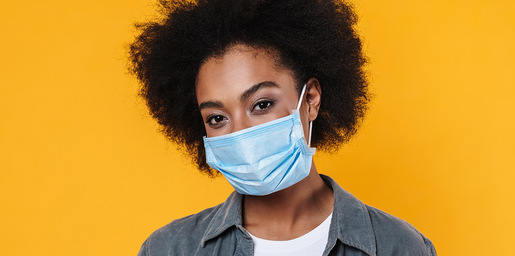How To Prevent And Treat Maskne

While Maskne might be new to many of us, it’s always been an issue in professions where you have to wear a mask regularly, but now that the general public has to wear masks, the incidence of it has increased.
So, what is Maskne? It can be defined as an array of skin issues arising from the use of protective masks, including acne. Warm weather, exertion and/or warm breath can all cause the type of environment that’s perfect for microorganisms to grow, which can lead to acne, perioral dermatitis (a facial rash around the mouth), rashes, folliculitis (inflamed hair follicles) and rosacea flares.
Plus, the friction from the mask making contact with our skin aggravates existing skin conditions. Add, skincare and makeup products to the mix, and you can expect unhappy skin.
That’s why prevention is key. If you are prone to acne, good skincare is a must. This means removing make up at the end of the day, and sticking to a consistent skincare routine.
Exfoliation can also help to prevent clogged pores as well as using retinoids or spot treatments to treat and prevent acne. Slugging, the process of applying an occlusive moisturizer such as Vaseline Original Healing Jelly before bed, can also help soothe any irritation caused by mask use. By sealing in all of your serums and moisturizers with a thin layer of Vaseline Original Healing Jelly on top, you can create a barrier that locks in moisturizing, soothing and healing ingredients, which can in turn help heal irritated skin caused by masks.
If your skin care regimen fails to improve your maskne, consider seeing a board-certified dermatologist, as acne around the lower face may signal hormonal acne, which is an easy fix.
Aside from acne, there are other common skin conditions you may run into, and if so, here’s what you can do to help take care of your skin:
Perioral dermatitis , commonly seen as a facial rash, can be frustrating to treat and it may be aggravated by mask wearing. To avoid this, be sure to decrease any possible causes for skin irritation of the perioral dermatitis by keeping your mask clean, using non-fragrant detergents and changing masks daily.
Irritant and allergic contact dermatitis can occur while using masks, be it from the friction, saliva on the skin, detergents that are being used, or even dyes and chemicals in the fabric of the mask. If your skin is sensitive, consider these factors when choosing and washing a mask:
- Fabrics: Stay away from synthetic fibers like polyester and stick to cotton. Other ingredients in your skincare routine may also be the source of an allergic contact dermatitis that may be mistaken for maskne.
- Keep Track : Keep a diary of when the rash occurs as well as exposures and products being used on the skin to find the culprit. If the rash persists, seek help from an allergist or a dermatologist who can test your skin to find the source of the problem. Remember, we can develop allergies as we get older, so, just because a certain product has been used for years, doesn’t mean it won’t cause an allergy later in life.
Seborrheic dermatitis , commonly known as “dandruff” on the scalp, can also occur on the face. Areas on our body rich with sebaceous glands like our scalp and face, can be particularly vulnerable to seborrheic dermatitis. Add mask wearing to the mix, and the appearance of seborrheic dermatitis can worsen. You can prevent this by removing your masks whenever possible to remove the warm humid air, and wash your face or wipe down with a facial wipe often.
Folliculitis , is a common skin condition that occurs when hair follicles become inflamed. It has many causes including friction from masks, as well as bacterial and fungal overgrowth due to mask wearing. One way to prevent folliculitis caused by friction is to trim facial hair so that the hair follicles don’t get irritated. For men, shave in the direction of hair growth to avoid inflammation and practice good skin care to ensure that debris, bacteria and fungus is washed away twice daily. If the folliculitis persists despite your best efforts, consider seeing your dermatologists as sometimes folliculitis may require treatment with oral antibiotics or oral antifungals.
Rosacea can present itself as just redness, or even pimples and pustules, and is often confused with acne. The warm air and friction from masks can exacerbate even well controlled rosacea. To prevent this, try to give your skin a break whenever possible and wash with ingredients known to help rosacea and acne, like sulfur. However, you may need to see your dermatologist for topical medications that can quickly calm down the rosacea caused by wearing masks.
Now that you are better equipped to prevent and treat the variety of skin issues under the guise of maskne, consider your skin’s unique needs. Maskne can present itself in many forms, and incorporating the above tips into your skincare routine, along with seeing a board-certified dermatologist, can help you beat your maskne.


